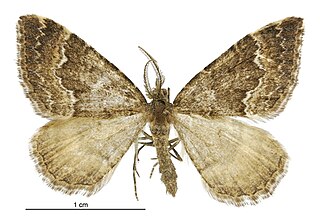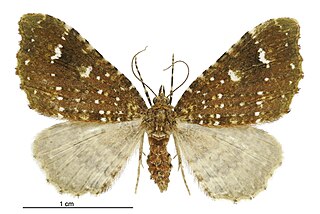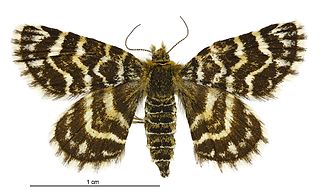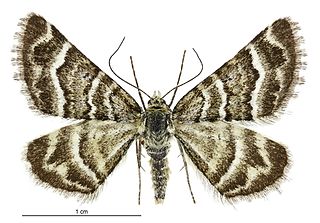Bascantis is a genus of moths belonging to the family Tineidae. It contains only one species, Bascantis sirenica, that is endemic to New Zealand. This species is classified as "Data Deficient" by the Department of Conservation.
Heterocrossa iophaea is a species of moth in the family Carposinidae. It is endemic to New Zealand.
Glaphyrarcha is a genus of moths in the family Carposinidae. It contains only one species Glaphyrarcha euthrepta. This species is endemic to New Zealand.
Chersadaula ochrogastra is a species of moth in the family Oecophoridae. This species is endemic to New Zealand. It is classified as "Data Deficient" by the Department of Conservation.
Archyala pentazyga is a species of moth in the family Tineidae. It was described by Edward Meyrick in 1915 using a specimen provided by George Vernon Hudson. Hudson collected the specimen at Days Bay in Wellington in January. It is endemic to New Zealand.

Apoctena orthocopa is a species of moth of the family Tortricidae. It is endemic to New Zealand, where it is found only on the North Island.

Culladia strophaea is a species of moth in the family Crambidae. It is endemic to New Zealand. The taxonomy of this species is currently uncertain.
Pyrgotis transfixa is a species of moth of the family Tortricidae. It is endemic to New Zealand. It is classified as "At Risk, Naturally Uncommon" by the Department of Conservation.

Thambotricha is a monotypic genus of moths in the family Epermeniidae. Its sole known species, Thambotricha vates, is also known by the vernacular name wonder-haired prophet. It is endemic to New Zealand. This species is classified as "At Risk, Naturally Uncommon" by the Department of Conservation.

Pseudocoremia albafasciata, also known as the flash moth, is a species of moth in the family Geometridae. It is endemic to New Zealand. It is classified as Nationally Endangered by the Department of Conservation.
Trachypepla cyphonias is a species of moth in the family Oecophoridae. It is endemic to New Zealand. This species is classified as "At Risk, Naturally Uncommon" by the Department of Conservation.
Tingena loxotis is a species of moth in the family Oecophoridae. This species is endemic to New Zealand. It is classified as "Data Deficient" by the Department of Conservation.

Notoreas chrysopeda is a species of moth in the family Geometridae. This species is endemic to New Zealand. It is a colourful day flying moth that lives in mountainous habitat.

Asaphodes ida is a species of moth in the family Geometridae. It is endemic to New Zealand. This moth can be found in upland or alpine habitat in Canterbury and Otago. Although not classified under the New Zealand Threat Classification system this species is regarded as rare.

Asaphodes limonodes is a species of moth in the family Geometridae. It is endemic to New Zealand.

Notoreas arcuata is a species of geometer moth endemic to New Zealand.

Notoreas hexaleuca is a species of moth in the family Geometridae. This species is endemic to New Zealand.

Notoreas ischnocyma is a species of moth in the family Geometridae. This species is endemic to New Zealand. This species is found in Canterbury and Otago.

Notoreas isoleuca is a species of moth in the family Geometridae. It is endemic to New Zealand.

Notoreas paradelpha is a species of moth in the family Geometridae. It is endemic to New Zealand.















